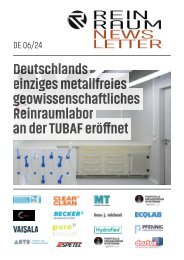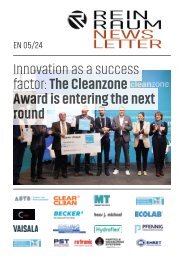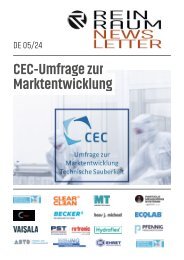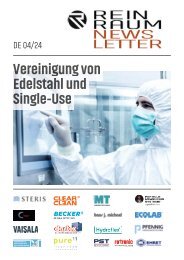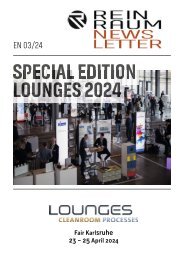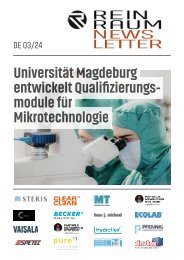Newsletter_03-2024_EN
In a quickly developing sector current information is especially important. On the one hand reinraum online offers interested persons the possibility to inform themselves comprehensively about current topics in the cleanroom branch. On the other hand companies and interested persons can use the platform to publish scientific reports, articles and company news. An event calendar complements the information offered. The ExpertPool helps with the advanced search: WHO is doing WHAT in cleanrooms. INTERNET:Current information is published daily/promptly on the internet on www.reinraum.de. NEWSLETTER: At the beginning of the month an interesting selection of the articles of last month is mailed as NEWSLETTER to all subscribers. NEWSFLASH: Between the monthly newsletters current information is sent via our NEWSFLASH to all subscribers. YEARBOOK: In January all selected articles of the last year are summarized in the CLEANROOM YEARBOOK.
In a quickly developing sector current information is especially important. On the one hand reinraum online offers interested persons the possibility to inform themselves comprehensively about current topics in the cleanroom branch. On the other hand companies and interested persons can use the platform to publish scientific reports, articles and company news.
An event calendar complements the information offered.
The ExpertPool helps with the advanced search: WHO is doing WHAT in cleanrooms.
INTERNET:Current information is published daily/promptly on the internet on www.reinraum.de.
NEWSLETTER: At the beginning of the month an interesting selection of the articles of last month is mailed as NEWSLETTER to all subscribers.
NEWSFLASH: Between the monthly newsletters current information is sent via our NEWSFLASH to all subscribers.
YEARBOOK: In January all selected articles of the last year are summarized in the CLEANROOM YEARBOOK.
Create successful ePaper yourself
Turn your PDF publications into a flip-book with our unique Google optimized e-Paper software.
PFAS analysis: Reliably detecting<br />
eternity chemicals<br />
– Planned ban on PFAS requires wide range of analysis methods<br />
– New devices, reference materials & co. for product control<br />
– analytica conference: PFAS in the focus of science<br />
Perfluorinated and polyfluorinated alkyl<br />
substances (PFAS) are colloquially known<br />
as “eternity chemicals” due to their persistence<br />
in the environment. PFAS do not<br />
occur naturally, but they can be found in<br />
all sorts of things from food packaging and<br />
outdoor textiles to seals and hoses. This<br />
group of substances, which comprises over<br />
10,000 compounds and is generally considered<br />
harmful to health, could soon be<br />
banned throughout the EU. The European<br />
Chemicals Agency is currently preparing a<br />
comprehensive regulation. When it comes<br />
into force, a number of products will have to<br />
be tested for PFAS before being put on the<br />
market. It is therefore hardly surprising that<br />
the further development of PFAS analysis is<br />
in full swing and is one of the biggest talking<br />
points at analytica <strong>2024</strong>.<br />
New instruments for PFAS analysis<br />
At analytica, all major manufacturers of<br />
devices for PFAS analysis will be present,<br />
including Agilent, Analytik Jena, Bruker,<br />
Gerstel, PerkinElmer, Shimadzu, Thermo<br />
Fisher and Waters. Conventional PFAS<br />
detection is based on the coupling of liquid<br />
chromatography (LC) and mass spectrometry<br />
(MS). For highly volatile, small<br />
PFAS, however, gas chromatography with<br />
MS detection is more suitable. Alternatively,<br />
nuclear magnetic resonance (NMR)<br />
spectroscopy and fluorine-specific detection,<br />
for example via Inductively Coupled<br />
Plasma (ICP)-MS, can be used. In view of<br />
the diversity of the substance group, which<br />
includes small gaseous substances as well<br />
as fluoropolymers, and the numerous products<br />
whose PFAS content must be monitored,<br />
various analysis techniques are required.<br />
analytica will provide information<br />
on the entire range of methods. Visitors can<br />
also look forward to new devices that help<br />
screen for thousands of unknown PFAS<br />
and reduce both the detection limit and the<br />
required sample quantity.<br />
Certified reference materials and analytical<br />
standards guarantee the reliability of<br />
PFAS analysis. The Joint Research Center<br />
of the European Commission and suppliers<br />
such as Campro Scientific, CPAchem, Labmix<br />
24, LGC Standards and Romil will be<br />
providing information on this at analytica.<br />
PFAS are difficult analytes because they<br />
adhere strongly to the walls of sample containers<br />
and other surfaces, making them<br />
difficult to detect. Isotope-labelled standards<br />
can be used to detect such effects and<br />
determine their recovery.<br />
The challenge of high blank values<br />
The biggest problem with PFAS analysis is<br />
the high blank values, as solvents and other<br />
consumables often contain traces of PFAS<br />
due to the production process. In addition,<br />
laboratory plastic articles and components<br />
of analyzers are often made of the fluoroplastic<br />
polytetrafluoroethylene (PTFE),<br />
which also leads to PFAS contamination<br />
and thus to high blank values. Some device<br />
manufacturers offer “PFAS-free kits” for<br />
LC/MS to replace tubes and other components<br />
which contain PFAS. Delay columns<br />
are also available for LC so that contaminants<br />
from the analysis system have a different<br />
retention time than the actual analytes.<br />
The analytica conference is dedicated<br />
to the PFAS issue as well, for example on<br />
April 9 at 11 a.m. in the session “Novel threats<br />
to food safety”. On April 10 at 2 p.m. in<br />
the session “Tracking anthropogenic emissions”,<br />
there will be an update from Brussels<br />
on the status of the planned regulation and<br />
the challenges of PFAS analysis. The Bunsen-Kirchhoff<br />
Award session on April 11 will<br />
focus on the detection of PFAS as a sum parameter.<br />
The analytica conference will take<br />
place at the ICM – International Congress<br />
Center Munich, near the exhibition halls,<br />
and is free of charge for all analytica visitors.<br />
At analytica, the topic will also be addressed<br />
in the Forum Laboratory & Analysis.<br />
Here, exhibitors will present specific<br />
analysis methods for PFAS chemicals, for<br />
example in the presentation “Advanced<br />
techniques for PFAS analysis with LC/MS”<br />
by Agilent.<br />
The combination of international trade<br />
fair and scientific conference offers contract<br />
laboratories, production plants and<br />
quality controllers from a wide range of industries<br />
the ideal opportunity to prepare for<br />
an EU-wide ban on the entire PFAS substance<br />
group.<br />
Messe München GmbH<br />
D 81823 München<br />
www.reinraum.de | www.cleanroom-online.com NEWSLETTER | Edition <strong>EN</strong> <strong>03</strong>-<strong>2024</strong><br />
page 16/33









